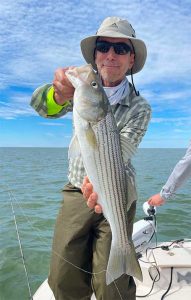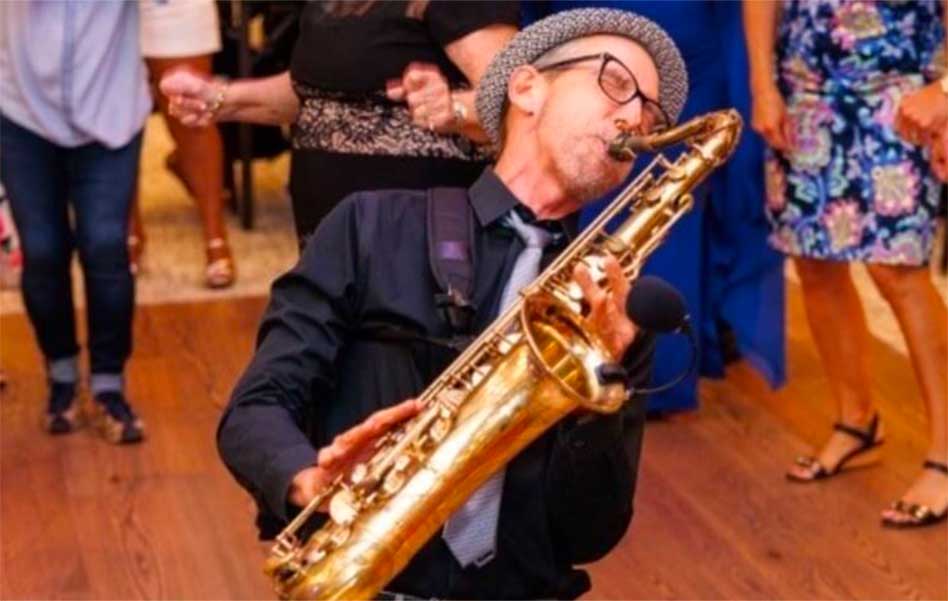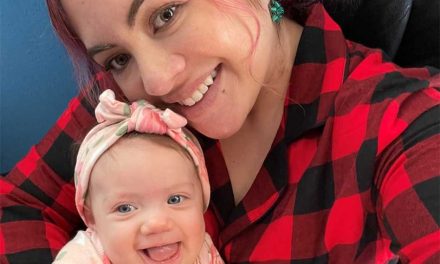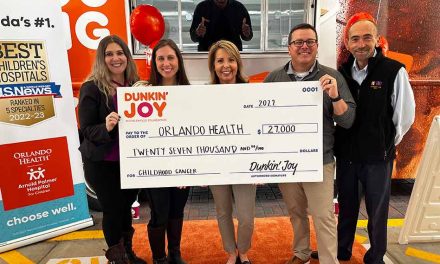John Harman loved his life — surfing, biking, fishing and relishing the natural world. He was a professional saxophonist whose work brought joy to others. He and his wife had a 12-year-old daughter they adored.
He’d always had allergies, so when a nasal drip lasted for months at the end of 2020, he didn’t think much about it. Harman, 56, hadn’t needed to see a doctor in years.
 About that time, the headaches set in. Then they got worse — and more frequent. He developed a numbness on the side of his nose. “Really weird,” he remembers. He went to an ear, nose and throat specialist who discovered a polyp. A scan showed a large mass that completely filled his sphenoid sinus, the hollow space in the bones around the nose. Even a biopsy would be tricky. The ENT recommended a colleague in Gainesville for the job.
About that time, the headaches set in. Then they got worse — and more frequent. He developed a numbness on the side of his nose. “Really weird,” he remembers. He went to an ear, nose and throat specialist who discovered a polyp. A scan showed a large mass that completely filled his sphenoid sinus, the hollow space in the bones around the nose. Even a biopsy would be tricky. The ENT recommended a colleague in Gainesville for the job.
“The idea of leaving our home and our child and our support system to go through this thing that he might not even survive was devastating,” John’s wife Aubrey Harman said.
Days later, the Orlando man was walking his dog when he got his diagnosis: a rare cancer called sinonasal undifferentiated carcinoma.
“First thing I did was google that,” Harmon said. “What I saw was a 50 percent survival rate of five years.”
Research was virtually nonexistent. His doctor was very, very concerned.
With heavy hearts, he and his wife, Aubrey, trooped 100-plus miles back to Gainesville and met more doctors. Harman could be treated in Gainesville or maybe Jacksonville. Either would require them to uproot themselves at the worst possible time and relocate far from friends and family — and perhaps from their young child — possibly for months. His prognosis at either facility was marginal. The best advice that could be offered? Visit an estate planner.
They needed to make a decision — and quickly. And then, a sign.
Every day on her way to work as a nurse practitioner at a center for vascular medicine, Aubrey passed a billboard advertising local cancer treatment. “Choose Orlando Health,” it said. Listening to a specialist in Gainesville tell her husband he had only a 30 percent chance of survival, she thought of his parents in St. Pete, and her parents in Windermere, and their child, at home. She wondered, was there any chance John could be treated in Orlando? “When it occurred to us to ask, the sign came to mind,” she says.
Turns out the answer was yes, he could. Orlando Health Cancer Institute offered his best chance of survival: proton therapy. “We never looked back,” John said.
Prepared for the Worst
Although sinonasal undifferentiated carcinoma is quite rare — only about 2,000 cases a year, compared to 45,000 to 50,000 cases for other kinds of head and neck cancers — it behaves “very aggressively,” says Harman’s medical oncologist at Orlando Health Cancer Institute, Dr. Jennifer Tseng. Chemo was needed because “this is such an aggressive tumor with high recurrence” that surgery and radiation alone “generally are not curative.”
Harman underwent five rounds of chemo that shrank the tumor. The strategy was to then destroy it completely with proton therapy, which harnesses the power of positively charged subatomic particles to target tumors in very specific ways. It’s especially beneficial in treating cancers in delicate areas like the base of the skull, the brain, and nasal and throat structures.
His doctors prepped him to receive the maximum radiation that can be administered to the head. “They prepared us for the worst,” Aubrey says. “He might not ever be able to work again, to be a musician, to do the things he loved.”
After seven weeks of therapy, they had their answer. The tumor was gone. John has been cancer-free since treatment, and returns to Orlando Health every four months for follow-up visits.
He has soreness in his neck and skull, loss of saliva and some hearing loss in one ear, “but nothing I can’t live with,” he says. “It was a big win.”
Today he’s back to long-distance biking, fishing, and is playing more gigs than ever before as a saxophonist, singer and guitarist. “To see him recover in such an amazing way is so unexpected. It’s phenomenal,” Aubrey said. “We’re so grateful. We talk about it every day.”
A Sacred Trust
Technology may have saved John’s life. But that’s not what has stuck with the Harmans.
Less than a month into his radiation treatment, still nauseous and throwing up from the chemo, John lost the ability to swallow even water, an emergency situation. “That was the low point,” he says. During the worst of his ordeal, “Dr. Tseng was always so available to us,” Aubrey said. “She would personally call after hours and told us how to handle any problems. We always felt like we could get hold of her.”
It takes a team to successfully undergo treatment, Dr. Tseng says.
“Patients put their trust in you, which is really a very sacred role,” Dr. Tseng says. “There are a lot of ingredients to healing — John and Aubrey were amazing in that they did everything possible. He exercised through treatment and ate healthy even when he was struggling with GI issues.”
The team approach is central to everything Orlando Health does. “Nobody can do this work in a vacuum,” Dr. Tseng says. From physicians to the nursing staff, navigators, medical assistants, radiation technicians, physicists, nutritionists and more, “any individual patient might have 30 people on their team.”
All of that support matters. “It could have been so much worse if not at Orlando Health,” Aubrey said. “Aside from the great local doctors and excellent medical care, John had support from his family, that stability of being at home. That comfort and emotional support could have been taken away if we had to move. Instead, he got even better care in his hometown. Even location aside, Orlando Health was the best option.”
By Mary Frances Emmons, Editorial Contributor, Orlando Health


















